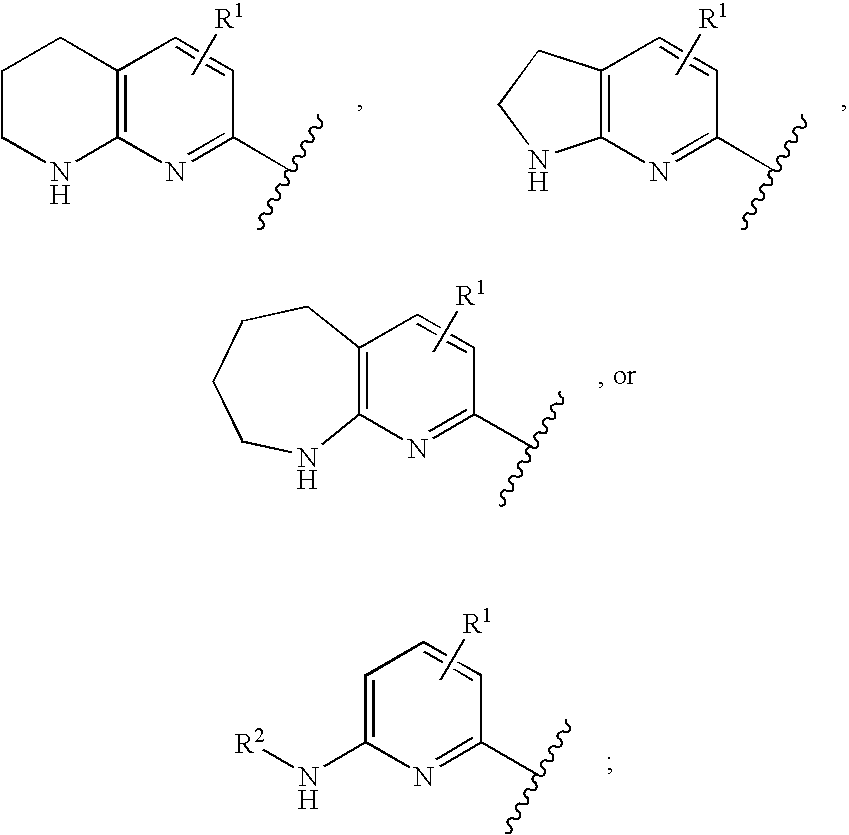Alpha v integrin receptor antagonists
a technology of integrin receptor and antagonist, which is applied in the direction of drug composition, peptide/protein ingredient, metabolic disorder, etc., can solve the problem of increasing fracture risk
- Summary
- Abstract
- Description
- Claims
- Application Information
AI Technical Summary
Benefits of technology
Problems solved by technology
Method used
Image
Examples
example 1
5,5-Difluoro-3(S or R)-(2-methyl-pyrimidin-5-yl)-9-(5,6,7,8-tetrahydro-[1,8]naphthyridin-2-yl)-nonanoic acid (1-12a)
Step A: 6-Oxo-heptanoic acid methyl ester (1-2)
[0251]To a rapidly stirred mixture of diethyl ether (175 ml) and 40% KOH (52 ml) at 0° C. was added MNNG (15.4 g, 105 mmol). The mixture was stirred for 10 minutes. The ethereal layer was transferred to a solution of 6-oxo-heptanoic acid 1-1 (5.0 g, 34.68 mmol) and CH2Cl2 at 0° C. The solution was purged with argon for 30 minutes and then concentrated. Flash chromatography (silica, 30–50% EtOAc / hexanes) gave ester 1-2 as a clear oil.
[0252]TLC Rf=0.88 (silica, EtOAc).
[0253]1H NMR (300 MHz, CDCl3) δ 3.67 (s, 3H), 2.46 (m,2H), 2.33 (m, 2H), 2.14 (s, 3H), 1.62 (m, 4H).
Step B: 5-[1,8]-Naphthyridin-2-yl-Dentanoic acid methyl ester (1-4)
[0254]A mixture of 1-2 (1.4 g, 9.04 mmol), 1-3, 2-amino-3-formylpyridine (552 mg, 4.52 mmol) (for preparation, see: J. Org. Chem., 1983, 48, 3401), and proline (260 mg, 2.26 mmol) in absolute etha...
example 2
5,5-Difluoro-3(R or S)-(2-Methyl-pyrimidin-5-yl)-9-(5,6,7,8-tetrahydro-[1,8]naphthyridin-2-yl)-nonanoic acid (1-12b)
[0276]Enantiomer 1-12b is obtained from 1-10b utilizing the same methods described for the preparation of 1-12a in Example 1 above. Its 400 MHz NMR spectrum in d6-DMSO is identical to that of its enantiomer 1-12a.
[0277]
example 3
9-(3-Cyclopropyl-5,6,7,8-tetrahydro-[1,8]naphthyridin-2-yl)-5,5-difluoro-3(S or R)-(2-methyl-pyrimidin-5-yl)-nonanoic acid (2-10a)
Step A: N-(3-Formyl-pyridin-2-yl)-2,2-dimethyl-propionamide (2-2)
[0278]To a cooled (0° C.) solution of 2-amino-3-formylpyridine 2-4 1 (50 g, 409 mmol) in 700 mL of anhydrous CH2Cl2 were added Et3N (80 mL, 532 mmol) in one portion and a solution of trimethylacetyl(pivaloyl)chloride (65 mL, 491 mmol) in 50 mL CH2Cl2 gradually over 40 min. The reaction mixture was stirred 30 min and concentrated to a syrup, then 200 mL water was added. The mixture was extracted three times with ethyl acetate. The combined organic layers were washed with water, brine and dried over MgSO4 and concentrated to afford the desired product 2-2 as a solid.
[0279]1H NMR (400 MHz, CDCl3): δ 10.85 (s, 1H), 8.70 (s, 1H), 8.0 (s, 1H), 7.20 (q, 1H), 1.30 (s, 9H).
Step B: 3-Cyclopropyl-[1,8]naphthyridin-2-ol (2-4)
[0280]To a cooled solution (−78° C.) of LDA (2.0 M, 251 mmol) in 600 mL THF was...
PUM
| Property | Measurement | Unit |
|---|---|---|
| diameter | aaaaa | aaaaa |
| temperature | aaaaa | aaaaa |
| temperature | aaaaa | aaaaa |
Abstract
Description
Claims
Application Information
 Login to View More
Login to View More - R&D
- Intellectual Property
- Life Sciences
- Materials
- Tech Scout
- Unparalleled Data Quality
- Higher Quality Content
- 60% Fewer Hallucinations
Browse by: Latest US Patents, China's latest patents, Technical Efficacy Thesaurus, Application Domain, Technology Topic, Popular Technical Reports.
© 2025 PatSnap. All rights reserved.Legal|Privacy policy|Modern Slavery Act Transparency Statement|Sitemap|About US| Contact US: help@patsnap.com



